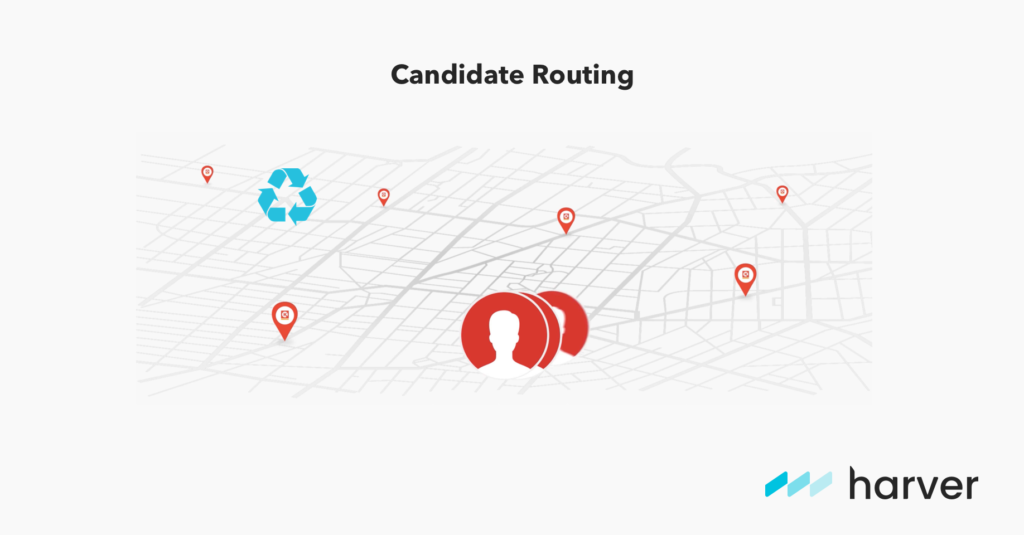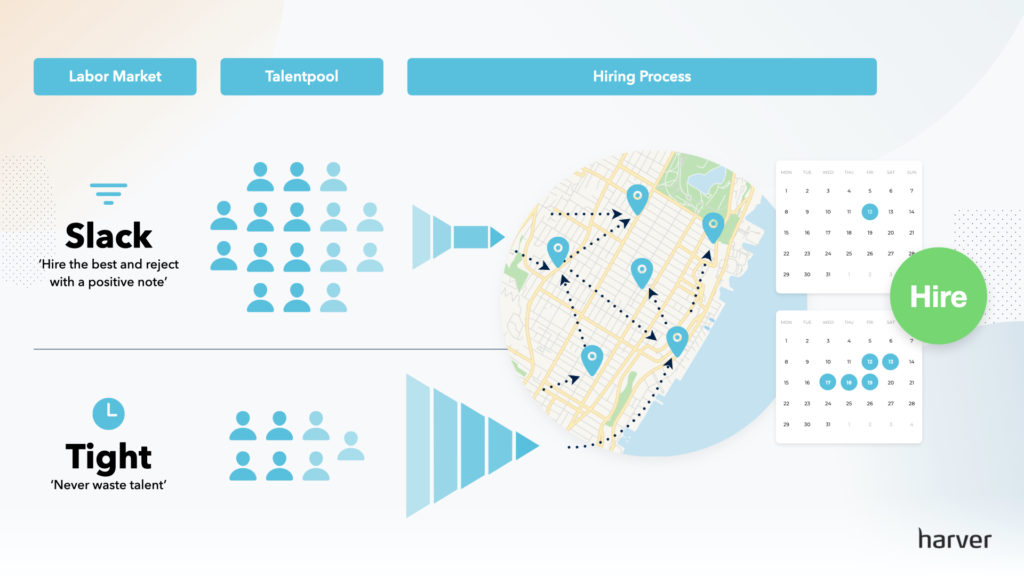In the current context, with candidate shortages all over the world, volume hiring recruiters in industries such as retail, hospitality or warehousing – businesses that also face the challenge of multi-location hiring – need to find innovative ways to fill their hourly role vacancies.
While their immediate tendency is to increase advertising budgets to source more candidates, adjusting their hiring process to get the most out of their existing talent pool is actually a smarter strategy.
This means not only using matching technology to assess candidates’ skills and match them to available roles, but also using dynamic routing or geo-matching to redirect candidates to locations and jobs they wouldn’t otherwise apply for.
Just because an applicant isn’t the right person for the entry level hourly role you’re hiring for, doesn’t mean they aren’t the right person for a similar level role, with the same skill and qualification requirements, just in a different location.
What does this look like in practice?
Let’s dive in and explore how you can improve fill rates in your hourly roles by routing candidates between locations.
What's in?
Like what you see?
Don’t miss out. Subscribe to our quarterly digest to get the latest TA and TM resources delivered right to your inbox.
What is applicant routing?
Applicant routing is a way of improving the efficiency in your volume recruitment process. Applicant routing sends applications or redirects candidates to a different location than the one they initially applied to.

The idea behind it is simple: if the initial location doesn’t have available roles, don’t reject the applicant and lose them from your organization, send them to another of your locations that needs them.
Which employers benefit the most from applicant routing?
Multi-location employers in industries such as retail, hospitality – hotel chains, restaurant chains, QSRs – and healthcare employers will benefit the most from applicant routing. This is because these sorts of industries offer entry level jobs, many of which are hourly roles that have limited skill and experience requirements.
Essentially, applicants who apply for one role but are unsuccessful, may be equally suited to work in a different role, elsewhere.
If you’re looking to hire in a supermarket, but the location is almost full or you typically get stronger candidates applying to work there, you can offer applicants with a lower matching score, a different role within your organization that they might not have thought to apply to, i.e. in warehousing, or in a different location, thus giving them a job and improving your fill rates.
Why applicant routing is perfect for multi location hiring
If you think volume hiring for one location is challenging, try doing it for multiple locations. If your organization has a decentralized, manual hiring process, where the task of recruiting lies solely with individual location managers, it means your hiring process is not only wildly inefficient, it could also see you miss out on those much sought after candidates.
Why? Because if some locations see a lot of applicants and others are less popular, your hiring managers could be turning applicants away because they don’t need them, without realizing they could be of use elsewhere.
If hiring managers don’t have an overview of the roles available across all locations, they don’t know if or when to route a candidate to a different location. Plus, if candidates have to submit multiple applications for the same position at different stores, they might fill in one or two, but they’re definitely not going to apply to every one of your stores that has a job that interests them.
If you use technology to automatically route applicants between locations, you won’t lose potential candidates again. We’ve detailed this topic in the webinar below.
Applicant routing with Harver
At Harver, we offer a Geo-Matching functionality that makes it easy for multi-location employers to fill open positions in locations with varying demand and supply. Here’s what this looks like.
Ready to transform your hiring process?
For example, if your organization is hiring similar entry level roles in various locations across the same city, rather than have candidates apply to each one individually, prompt candidates during the application process to indicate which of the available locations they would be interested in working at.
At the same time, highlight the likelihood of them getting applied at each one, based on your current supply and demand data.
Once you’ve assessed applicants for organization and job fit, candidates can see where they should apply (i.e. those less popular locations) to increase their chances of getting hired. You then route interested candidates between locations to meet demand. It’s a win-win for both parties.
Automating this step of your hiring process uses your talent pool more efficiently – and when the talent pool is shallow, every little helps. Routing candidates between locations also reduces time to commitment, i.e. you snap up talent quicker, and it helps candidates get job security faster.
For example, Albert Heijn, a Netherlands-based grocery store chain with 1000+ locations, achieved 42% more applications through dynamic routing and 48% routed hires by hiring candidates in positions they didn’t apply for.
If you’d like to see how Harver can help your organization achieve similar results, you can book a demo below.
Ready to transform your hiring process?
Best practices for improving fill rates through applicant routing
1. Start with the big picture
Before you begin, you need to have complete oversight of all your locations and what roles they’re hiring for. To do this, compile a centralized list of all your locations that hire for similar roles before posting your job ads.
If you can, sort the list into which locations are likely to receive more applicants due to their more favorable position, and which are likely to struggle to find candidates.
2. Facilitate multi location applications
Give candidates the opportunity to apply to multiple locations at once, saving them time and making the process more efficient for both of you. Utilize a volume hiring solution like Harver that allows multi-location applications i.e. when a candidate applies for one role, all of your locations that recruit for similar positions also receive their application.
Just remember, not every candidate is going to want to apply to another location, or take another position. And that’s OK. Gauge their interest early, preferably during the application stage itself. If candidates indicate that they don’t want to accept an alternative offer, you know not to waste your time moving them along your application funnel.
3. Show the locations with fewer applicants at the top of the list
Make it incredibly easy for applicants to apply at the locations you’re struggling to hire at. When you give candidates the option to select the locations they want to work for, place your less popular locations at the top of the list.
Highlight to applicants that if they apply to work at any of the locations at the top of your list, the chance of being hired there is higher, due to fewer competing candidates.
4. Route rejected applicants to locations with less supply
Rather than filling open roles through vacancy-driven matching, use two way matching. Harver provides matching scores for candidates beyond just the original open position.
By running a variety of skill assessments, rather than just those the position requires, you can look beyond an applicant’s skills and qualifications and see their suitability and fit within your organization and your family of jobs. Just because someone doesn’t have the skills that make them right for a particular role, doesn’t mean they aren’t right for a similar role, elsewhere in your company.

By doing this, when you reject applicants from one role, you don’t dismiss them from your company completely. Rather, you keep them in your talent pool and in your organization, so that when new positions become available, you already have suitable candidates – you don’t have to start from scratch every time with your recruiting.
For example, if you’re hiring to fill hourly roles in a grocery store, but you also need to fill hourly roles in your warehouse, and both roles are entry-level, i.e. they require no special skills, you can route rejected applicants from the grocery store to fill the warehouse roles (if they would like).
Not only does this reduce your recruitment costs, it also means you can build a diverse and inclusive workforce because you are dipping into a talent pool replete with potential candidates with different profiles and backgrounds.
5. Automate applicant routing with technology
To realize efficiency and improve fill rates in your hourly roles by routing candidates between locations, you need to automate the process.
When multi-location recruiting, typical challenges include:
- Location managers aren’t recruiters and they aren’t trained to hire efficiently, bias free, at scale.
- Decentralized recruitment where HQ have little or no insight into hiring decisions.
- Lengthy application processes where candidates have to wait around for store managers to find time in their already overflowing work schedules to respond.
- Volatile labor markets that vary by industry and geography.
If you want to fill roles faster, make your hiring process more efficient than the competition. That means automating tasks that don’t need a human touch i.e. routing candidates. By automating applicant routing with technology, you remove any human touch from the process, taking away potential bottlenecks and bias.

6. Facilitate international applications
If you can’t find enough applicants to fill your hourly roles by looking inside your country’s borders, extend your search overseas, and facilitate international applications. If you’re hiring for seasonal jobs, this is definitely something to consider.
While it allows you cast a wider hiring net, there are legal and logistical considerations to take into account to ensure your international hires are successful, for example: you’ll need to provide evidence that you can’t find suitable candidates at home. Considering we’re experiencing the tightest labor market we’ve seen in a long time, that shouldn’t be a tough sell.
Next steps
It might seem like delivering high volume recruitment in the current labor market is an impossibility, but it’s not. As shown above, one way to improve your fill rate in hourly roles is to automatically route candidates between your various locations, based on demand and supply.
With automatic prompts early in your recruitment process that encourage candidates to apply to your various locations all at once, and with the added incentive of a higher chance of employment if they apply to a less competitive location, you’ll improve your fill rate.
How do we know this? Because Harver is built for volume hiring. Over the last 6 years we’ve helped innovative global companies just like yours, transform their manual, inefficient volume hiring processes into fast, efficient, digital experiences.
If you’d like to see how Harver can help your multi-location organization improve your hourly role fill rates, you can book a demo below.
Ready to transform your hiring process?




